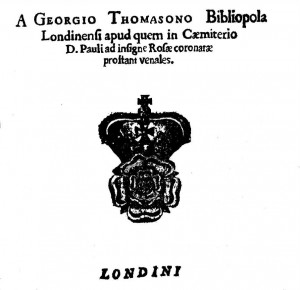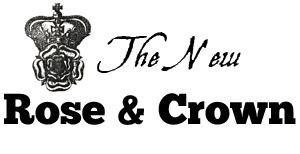 The first Rose and Crown was a publishing house located on the north side of the churchyard of St. Paul’s cathedral in London in the 17th century. In the early 1600s its proprieter, Henry Fetherstone, was a prominent London publisher and officer in the Stationers’ Guild. Today, one of his most important surviving publications is Samuel Purchas, His Pilgrims …
The first Rose and Crown was a publishing house located on the north side of the churchyard of St. Paul’s cathedral in London in the 17th century. In the early 1600s its proprieter, Henry Fetherstone, was a prominent London publisher and officer in the Stationers’ Guild. Today, one of his most important surviving publications is Samuel Purchas, His Pilgrims …
At some time early in the 1620s he apprenticed George Thomason. Henry later took George on as a partner and allowed him to marry his niece and ward, Catherine Hutton. The Thomasons were good friends of the poet Milton, who wrote and dedicated his Sonnet xiv to the memory of Catherine at her death. George was a political activist and advocate of democracy, opposing King Charles I as a member of the London Common Council, and seeking to reform the Stationers’ Guild to one man-one vote and economic equality.
But George is best known to history because from the beginning of the English Long Parliament and subsequent civil war (1641-1661), he took upon himself the mission of preserving every publication produced, in the open or clandestinely, in London. Since each side in the conflict destroyed the other’s publications this was difficult, risky, and enormously expensive. Some 25,000 books, pamphlets (including George’s own broadside against Cromwell’s New Model Army, Six New Queries), newspapers and even songsheets survive in in the Library of the British Museum as the Thomason Collection, in more than 2,000 leather volumes from the 30,000+ items he collected, bound, annotated, cataloged, and hid from the authorities (in hollow walls, etc.).
The Rose and Crown survived at least until George’s death in 1666. The New Rose and Crown, operated by a descendant, is dedicated to providing Free-/ Re-/ and E-prints in the spirit of free access to information and the preservation of knowledge and history to which George Thomason dedicated much of his life and wealth, and for which he risked his freedom.

2 comments
Robert F. Smith says:
Nov 4, 2010
Looking good, Gordon, but still a little bare. However, a journey of a thousand blogs and infinite threads begins with one post. So here I am.
Bob
gordon says:
Jun 26, 2012
Bob,
So of 161 replies to my site, one from a relative and one from you weren’t junk or worse. No wonder I’ve avoided reviewing them after clicking delete in the first place.
g